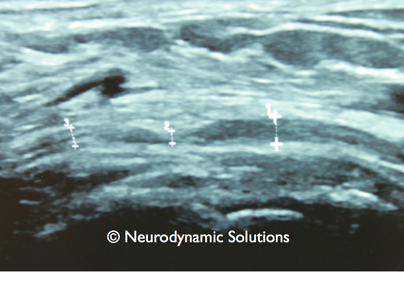
Plantar Fasciopathy/itis and Medial Calcaneal Neuropathy
(companion article) Clearly, plantar fasciitis is common and can be difficult to treat. In a recent study of patients with plantar fasciitis verified with diagnostic ultrasound, electrophysiological function of the medial calcaneal nerve has shown some important results. Twenty-six subjects were selected on the basis of having plantar fasciitis that was demonstrated with ultrasound diagnostic imaging. Of these, six (23%) showed abnormal latency and amplitude of the medial calcaneal nerve. Imagine if 23% of the people in the world who ever had plantar fasciitis also had this neuropathy. That is a lot of people, so this neuropathy is very important for this patient group. Electrophysiological abnormality is the gold standard for demonstrating peripheral neuropathy. However remember that this study was performed in a certain context - patients with plantar fasciitis. So automatically, the patient group was small because it was localized to patients who already had that specific diagnosis. What about people with heel and foot pain who have no radiologically evident problem in their plantar fascia? Since ultrasound diagnosis is not perfectly sensitive, the plantar fasciitis may not be visible with ultrasound even though neuropathy may still exist. So what would be the percentage of people with HEEL PAIN (as opposed to plantar fasciitis ) who have a medial calcaneal neuropathy? No one knows but this highlights the importance of detailed and proficient examination. This would necessitate performing neurodynamic tests, neurological evaluation and palpation of the nerve and associated structures in and around the tarsal tunnel, along the tibial nerve to the medial calcaneal nerve. Reference Chang C, Wang Y, Hou W, Lee X, Chang K 2007 Medial calcaneal neuropathy is associated with plantar fasciitis. Clinical Neurophysiology 118 (1): 119-123 See abstract |
 Ultrasound image of compressed medial calcaneal nerve in a patient with heel pain syndrome. Ultrasound image of compressed medial calcaneal nerve in a patient with heel pain syndrome.
Is it possible to see compression of the medial calcaneal nerve with ultrasound?
The answer is yes. Here is an ultrasound image of one of my patients with heel pain, showing constriction of the medial calcaneal nerve. See the middle point in the image where the constriction is demonstrated. Amongst other things, he had reproduction of pain in the heel with palpation of the nerve. This is an important nerve problem and we should consider it as a routine differential diagnosis in all patients with heel and foot pain. |
